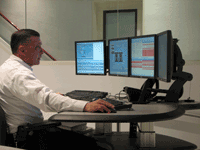 The work of stationary engineers is varied and complex. We are responsible for the operation, maintenance, renovation and repair of boiler systems and all other mechanical systems in a facility. Stationary engineers are employed in schools, hospitals, hotels, apartment buildings, shopping malls, airports, power plants, industrial and manufacturing plants, breweries, co-generation plants, petro-chemical plants, office and commercial buildings, government facilities and other workplaces. In operating and repairing these facilities, stationary engineers perform work on boilers and steam systems; heating, ventilating and air conditioning systems; building automation systems; diesel engines, turbines, generators; pumps, piping and compressed gas systems; refrigeration and electrical systems and numerous other physical plant functions. We are called stationary engineers because the equipment we operate is similar to equipment operated by locomotive or marine engineers except it is not in a vehicle that moves.
The work of stationary engineers is varied and complex. We are responsible for the operation, maintenance, renovation and repair of boiler systems and all other mechanical systems in a facility. Stationary engineers are employed in schools, hospitals, hotels, apartment buildings, shopping malls, airports, power plants, industrial and manufacturing plants, breweries, co-generation plants, petro-chemical plants, office and commercial buildings, government facilities and other workplaces. In operating and repairing these facilities, stationary engineers perform work on boilers and steam systems; heating, ventilating and air conditioning systems; building automation systems; diesel engines, turbines, generators; pumps, piping and compressed gas systems; refrigeration and electrical systems and numerous other physical plant functions. We are called stationary engineers because the equipment we operate is similar to equipment operated by locomotive or marine engineers except it is not in a vehicle that moves.
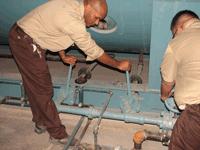
Stationary engineers start up, regulate, repair and shut down equipment. We ensure that equipment operates safely and economically and within established limits by monitoring attached meters, gauges, and computerized controls. We manually control equipment and make the necessary adjustments. We use hand and power tools to perform repairs and maintenance ranging from a complete overhaul to replacing defective valves, gaskets, or bearings. We also record relevant events and facts concerning operation and maintenance in an equipment log. On steam boilers, for example, we observe, control, and record steam pressure, temperature, water level, power output, and fuel consumption. Stationary engineers can often detect potential mechanical problems by observing and listening to the pitch of the machinery. We routinely check safety devices, identifying and correcting any trouble that develops.
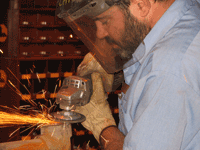 Stationary engineers also perform routine maintenance, such as repairing and replacing pumps, motors and other operating equipment, lubricating moving parts, replacing filters, and removing soot and corrosion that can reduce operating efficiency. We also test and chemically treat hydronic systems to prevent corrosion and harmful deposits.
Stationary engineers also perform routine maintenance, such as repairing and replacing pumps, motors and other operating equipment, lubricating moving parts, replacing filters, and removing soot and corrosion that can reduce operating efficiency. We also test and chemically treat hydronic systems to prevent corrosion and harmful deposits.
A stationary engineer may be in charge of operation, maintenance and repair of all mechanical systems in a building, industrial power plant or engine room. A chief engineer may direct the work of assistant stationary engineers, turbine operators, boiler tenders, and air-conditioning and refrigeration operators and mechanics. In a small building or industrial plant, there may be only one stationary engineer at a time who will be responsible for the entire operation and maintenance of the building or facility.
What do I need to become a stationary engineer?
-
An average of four years of apprentice training, including on-the-job and classroom training.
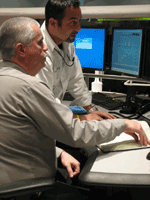
-
A good work ethic and responsible attitude.
-
An interest in learning highly technical subjects like boiler operation and maintenance, air conditioning and refrigeration, safety, practical chemistry, elemental physics, instrumentation and controls, electronics and computer controls.
-
A willingness to keep learning. Due to the increasing complexity of the equipment, stationary engineers must continue to update their skills, and many go on to take college courses.
-
The ability to do shift work, and to work on weekends and holidays.
How do I get accepted into an IUOE apprentice training program for stationary engineers?
Selection criteria vary from one local to another, so you should contact an IUOE stationary local in your area for specific information. However, minimum requirements include that applicants be at least 18 years old, have a high school diploma or GED, be legal to work and drug free. Having previous mechanical or technical experience would be helpful, but may not be necessary.
What training does IUOE provide for apprentice stationary engineers?
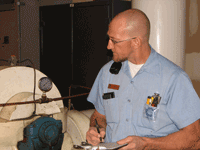 High quality, skill development training is provided by apprenticeship and training programs at IUOE stationary local unions. These recognized programs are jointly sponsored by IUOE local unions and the employers who hire stationary engineers.
High quality, skill development training is provided by apprenticeship and training programs at IUOE stationary local unions. These recognized programs are jointly sponsored by IUOE local unions and the employers who hire stationary engineers.
The average length of a stationary engineer apprenticeship is four years. During this period, apprentices learn their craft by working with skilled stationary engineers at an actual workplace, and by attending related classroom instruction. In some cases, apprentice training is supplemented by courses at trade or technical schools and, due to the increasing complexity of the equipment with which they work, many stationary engineers have also taken college courses. Training is critical to preparing apprentices to be tested for stationary engineer licenses, which is required by most states.
Journey level stationary engineers are often encouraged by their employers to continue their education. Many IUOE locals offer free training to their members to help them broaden their skills, keep up with changes in the industry and improve their employability. Additional training has helped many IUOE members move up to management or supervisory positions.
How much do stationary engineers earn?
Journey level and apprentice wages vary considerably from one part of the country to another, so you will need to contact an IUOE local in your area for specific information. Starting pay for an apprentice varies from 45% to 60% of the journey level rate. Pay increases are scheduled at designated times during apprenticeship and are negotiated as part of each local’s contract with employers. During the final year of apprenticeship, wages are typically 80% to 95% of the journey level rate.